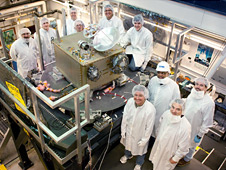Overview
Text Size
NASA's Glenn Research Center: Dreaming Big
 NASA's Glenn Research Center in Cleveland, Ohio researches, designs, develops and tests innovative technology for aeronautics and spaceflight. Image Credit: NASA
We design game-changing technology for spaceflight that enables further exploration of the universe. We create cutting-edge aeronautical technology that revolutionizes air travel. We inspire the next generation of explorers to dream big.
NASA's Glenn Research Center in Cleveland, Ohio researches, designs, develops and tests innovative technology for aeronautics and spaceflight. Image Credit: NASA
We design game-changing technology for spaceflight that enables further exploration of the universe. We create cutting-edge aeronautical technology that revolutionizes air travel. We inspire the next generation of explorers to dream big. We are NASA's Glenn Research Center. This is what we do.
****
NASA's Glenn Research Center in Cleveland, Ohio, is one of ten NASA centers. Glenn is an essential component of NASA and an integral contributor to the region.
Glenn:
- Has a decades-long tradition of excellence in aeronautics and spaceflight
- Makes key contributions in supporting NASA missions
- Is a vital element of the economy of the region
- Partners with local and national businesses
- Collaborates with colleges and universities
- Makes significant contributions to the research, design, development and testing of technology
- Is committed to education and outreach
- Shares the NASA message at schools, fairs and events around a six-state region:
-Ohio, Indiana, Michigan, Illinois, Wisconsin, Minnesota
- Promotes science, technology, engineering and mathematics (STEM) education
Evolving Excellence
NASA's Glenn Research Center was founded in 1941 by the National Advisory Committee for Aeronautics (NACA), which was the precursor to NASA. Glenn was initially called the Aircraft Engine Research Laboratory. After several name changes, in 1999 it received its current name, the NASA John H. Glenn Research Center. The center was named in honor of former senator John H. Glenn, an Ohioan who was the first American to orbit Earth when he piloted "Friendship 7" around the globe three times in 1962.
Located near Cleveland Hopkins International Airport and the Cleveland Metroparks' Rocky River Reservation, Glenn's main campus, Lewis Field, is situated on 350 acres of land and contains more than 150 buildings. The world-class facilities at Lewis Field include wind tunnels, drop towers, vacuum chambers and an aircraft hangar. Glenn's Plum Brook Station is located 50 miles west of Cleveland in Sandusky, Ohio, on 6,400 acres of land. Plum Brook Station has large, unique facilities that simulate the environment of space. Both locations enable NASA, other governmental agencies, and academic and industry partners from across the country to perform specialized research and testing.
More than 3,400 people work at Glenn, including civil servants and on-site contractors. A highly skilled workforce of scientists, engineers, technicians and administrative and support personnel comprise the robust and diverse Glenn team. Ramon "Ray" Lugo III currently serves as Glenn's director—the eleventh director in a distinguished line of leadership.
Innovative Expertise
Glenn supports all of the agency's missions and major programs. Glenn excels in researching and developing innovative technologies for both aeronautics and space flight. A multitude of NASA missions have included elements from Glenn, from the Mercury and Gemini projects to the Space Shuttle Program and the International Space Station.
Glenn's Core Competencies:
Air-Breathing Propulsion
- Advances airbreathing propulsion for aerospace vehicles
- Reduces energy consumption, noise, emissions and cost in air travel; increases use of alternative energy sources; improves safety and expediency in air travel
- Includes: engine cycles, advanced propulsion systems, component improvements, controls and dynamics, harsh environment sensors, electronics, instrumentation, health monitoring and management, materials and structures, power extraction and management, icing, fuels and propellants, acoustics, fluid mechanics, heat transfer, aerothermodynamics and plasmas
Communications Technology and Development
- Advances communications technologies
- Improves air traffic management, communications and navigation among satellites, aircraft, spacecraft, astronauts, robots and ground systems
- Includes: advanced antennas, integrated radiofrequency and optical terminals, software-defined radios, high-power amplifiers and networking for high-data-rate communications
 The Communications, Navigation, and Networking re-Configurable Testbed (CoNNeCT) enables the development of communications, navigation and networking technology. The CoNNeCT system is comprised of a flight system (on the International Space Station) and a ground system (located at Glenn). Image Credit: NASA
In-Space Propulsion and Cryogenic Fluids Management
The Communications, Navigation, and Networking re-Configurable Testbed (CoNNeCT) enables the development of communications, navigation and networking technology. The CoNNeCT system is comprised of a flight system (on the International Space Station) and a ground system (located at Glenn). Image Credit: NASA
In-Space Propulsion and Cryogenic Fluids Management- Advances spacecraft propulsion systems and cryogenic fluid flight systems
- Enables new mission capability; increases reliability, safety and affordability; reduces trip times
- In-space propulsion includes: propellants, chemical propulsion, and electric propulsion (ion, Hall, plasma) and nuclear propulsion
- Cryogenic fluid management includes: cryogenic fluids (oxygen, methane, hydrogen) handling, characterization, storage, delivery, demonstration and flight packages
Power, Energy Storage and Conversion
- Advances technologies for power generation, energy conversion and storage and power management and distribution
- Includes: solar power generation, batteries, fuel cells, regenerative fuel cells, flywheels, thermal energy conversion and heat rejection, radioisotopes, fission, power electronics and power management and distribution
Materials and Structures for Extreme Environments
- Advances materials, structures and mechanisms for aerospace systems subjected to extreme environments
- Improves: aircraft engines, space propulsion systems, planetary reentry, planetary surface operations and long-duration space travel
Physical Sciences and Biomedical Technologies in Space
- Advances physical and biomedical systems to enable sustainable exploration of space
- Enhances safety; extends mission duration; reduces potentially harmful effects of space.
- Includes: life support, fire safety, crew health monitoring and support, space resource utilization and thermal management
Ongoing Exploration
At NASA's Glenn Research Center, decades of experience are complemented by an enthusiasm for new challenges. The expertise of the workforce is matched by its passion and commitment. Whether pioneering the next generation of aerospace technology or educating the next generation of aerospace pioneers, Glenn dreams big.
05/11
NASA's Glenn Research Center